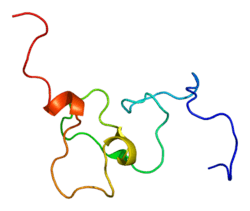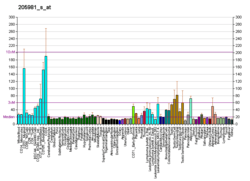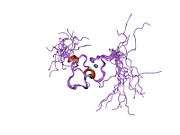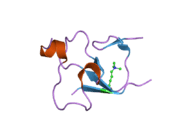ING2
Inhibitor of growth protein 2 is a protein that in humans is encoded by the ING2 gene.[5][6]
Function
This gene is a member of the inhibitor of growth (ING) family. Members of the ING family associate with and modulate the activity of histone acetyltransferase (HAT) and histone deacetylase (HDAC) complexes and function in DNA repair and apoptosis.[6]
References
- 1 2 3 GRCh38: Ensembl release 89: ENSG00000168556 - Ensembl, May 2017
- 1 2 3 GRCm38: Ensembl release 89: ENSMUSG00000063049 - Ensembl, May 2017
- ↑ "Human PubMed Reference:".
- ↑ "Mouse PubMed Reference:".
- ↑ Shimada Y, Saito A, Suzuki M, Takahashi E, Horie M (Mar 1999). "Cloning of a novel gene (ING1L) homologous to ING1, a candidate tumor suppressor". Cytogenetics and Cell Genetics. 83 (3–4): 232–5. doi:10.1159/000015188. PMID 10072587.
- 1 2 "Entrez Gene: ING2 inhibitor of growth family, member 2".
Further reading
- Bonaldo MF, Lennon G, Soares MB (Sep 1996). "Normalization and subtraction: two approaches to facilitate gene discovery". Genome Research. 6 (9): 791–806. doi:10.1101/gr.6.9.791. PMID 8889548.
- Nagashima M, Shiseki M, Miura K, Hagiwara K, Linke SP, Pedeux R, Wang XW, Yokota J, Riabowol K, Harris CC (Aug 2001). "DNA damage-inducible gene p33ING2 negatively regulates cell proliferation through acetylation of p53". Proceedings of the National Academy of Sciences of the United States of America. 98 (17): 9671–6. doi:10.1073/pnas.161151798. PMC 55510. PMID 11481424.
- Kuzmichev A, Zhang Y, Erdjument-Bromage H, Tempst P, Reinberg D (Feb 2002). "Role of the Sin3-histone deacetylase complex in growth regulation by the candidate tumor suppressor p33(ING1)". Molecular and Cellular Biology. 22 (3): 835–48. doi:10.1128/MCB.22.3.835-848.2002. PMC 133546. PMID 11784859.
- Gozani O, Karuman P, Jones DR, Ivanov D, Cha J, Lugovskoy AA, Baird CL, Zhu H, Field SJ, Lessnick SL, Villasenor J, Mehrotra B, Chen J, Rao VR, Brugge JS, Ferguson CG, Payrastre B, Myszka DG, Cantley LC, Wagner G, Divecha N, Prestwich GD, Yuan J (Jul 2003). "The PHD finger of the chromatin-associated protein ING2 functions as a nuclear phosphoinositide receptor". Cell. 114 (1): 99–111. doi:10.1016/S0092-8674(03)00480-X. PMID 12859901.
- Sironi E, Cerri A, Tomasini D, Sirchia SM, Porta G, Rossella F, Grati FR, Simoni G (Apr 2004). "Loss of heterozygosity on chromosome 4q32-35 in sporadic basal cell carcinomas: evidence for the involvement of p33ING2/ING1L and SAP30 genes". Journal of Cutaneous Pathology. 31 (4): 318–22. doi:10.1111/j.0303-6987.2004.0187.x. PMID 15005689.
- Chattopadhyay C, Hawke D, Kobayashi R, Maity SN (2004). "Human p32, interacts with B subunit of the CCAAT-binding factor, CBF/NF-Y, and inhibits CBF-mediated transcription activation in vitro". Nucleic Acids Research. 32 (12): 3632–41. doi:10.1093/nar/gkh692. PMC 484179. PMID 15243141.
- He GH, Helbing CC, Wagner MJ, Sensen CW, Riabowol K (Jan 2005). "Phylogenetic analysis of the ING family of PHD finger proteins". Molecular Biology and Evolution. 22 (1): 104–16. doi:10.1093/molbev/msh256. PMID 15356280.
- Chin MY, Ng KC, Li G (Apr 2005). "The novel tumor suppressor p33ING2 enhances UVB-induced apoptosis in human melanoma cells". Experimental Cell Research. 304 (2): 531–43. doi:10.1016/j.yexcr.2004.11.023. PMID 15748897.
- Barrios-Rodiles M, Brown KR, Ozdamar B, Bose R, Liu Z, Donovan RS, Shinjo F, Liu Y, Dembowy J, Taylor IW, Luga V, Przulj N, Robinson M, Suzuki H, Hayashizaki Y, Jurisica I, Wrana JL (Mar 2005). "High-throughput mapping of a dynamic signaling network in mammalian cells". Science. 307 (5715): 1621–5. doi:10.1126/science.1105776. PMID 15761153.
- Pedeux R, Sengupta S, Shen JC, Demidov ON, Saito S, Onogi H, Kumamoto K, Wincovitch S, Garfield SH, McMenamin M, Nagashima M, Grossman SR, Appella E, Harris CC (Aug 2005). "ING2 regulates the onset of replicative senescence by induction of p300-dependent p53 acetylation". Molecular and Cellular Biology. 25 (15): 6639–48. doi:10.1128/MCB.25.15.6639-6648.2005. PMC 1190357. PMID 16024799.
- Okano T, Gemma A, Hosoya Y, Hosomi Y, Nara M, Kokubo Y, Yoshimura A, Shibuya M, Nagashima M, Harris CC, Kudoh S (Mar 2006). "Alterations in novel candidate tumor suppressor genes, ING1 and ING2 in human lung cancer". Oncology Reports. 15 (3): 545–9. doi:10.3892/or.15.3.545. PMID 16465410.
- Wang J, Chin MY, Li G (Feb 2006). "The novel tumor suppressor p33ING2 enhances nucleotide excision repair via inducement of histone H4 acetylation and chromatin relaxation". Cancer Research. 66 (4): 1906–11. doi:10.1158/0008-5472.CAN-05-3444. PMID 16488987.
- Lu F, Dai DL, Martinka M, Ho V, Li G (Jul 2006). "Nuclear ING2 expression is reduced in human cutaneous melanomas". British Journal of Cancer. 95 (1): 80–6. doi:10.1038/sj.bjc.6603205. PMC 2360493. PMID 16755297.
- Wang Y, Wang J, Li G (Jul 2006). "Leucine zipper-like domain is required for tumor suppressor ING2-mediated nucleotide excision repair and apoptosis". FEBS Letters. 580 (16): 3787–93. doi:10.1016/j.febslet.2006.05.065. PMID 16782091.
- Huang W, Zhang H, Davrazou F, Kutateladze TG, Shi X, Gozani O, Prestwich GD (May 2007). "Stabilized phosphatidylinositol-5-phosphate analogues as ligands for the nuclear protein ING2: chemistry, biology, and molecular modeling". Journal of the American Chemical Society. 129 (20): 6498–506. doi:10.1021/ja070195b. PMC 2553394. PMID 17469822.
External links
- ING2+protein,+human at the US National Library of Medicine Medical Subject Headings (MeSH)
This article incorporates text from the United States National Library of Medicine, which is in the public domain.
This article is issued from
Wikipedia.
The text is licensed under Creative Commons - Attribution - Sharealike.
Additional terms may apply for the media files.







